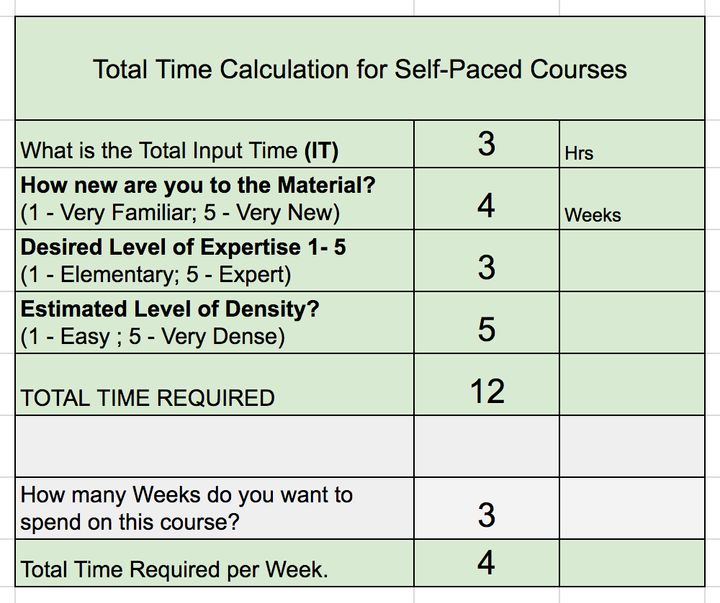
Video courses remind me of a gas tank - they appear small on the outside, but they contain a lot of stuff in a compressed form. Once you play a video, you let the gas out. The gas fills up the whole room. The gas is the information presented in the course. It’s not uncommon to see 40 hours of classroom time compressed into 5 - 10 hours of video.
You must keep this in mind when you plan and schedule your online learning. I draw a line between input time and processing time. Input time (IT) is the length of the video lesson. (IT) is easy to locate in the course summary. Processing time (PT) is the time it takes me to analyse the information learned and imprint it onto my brain. (PT) varies and depends on many factors.
One of my curious online students, Muhammad, asked for a specific formula which will help him estimate how much time he’ll need to learn from the video course.
Below is what I came up with.
Take three factors into consideration:
1. How new are you to the course material?
On the scale from 1 to 5, 5 being the biggest value (1 - very familiar; 5 - very new)
We tend to take more time when information is completely new to us and go faster through the topic we have experience in. For example, it will probably take a programmer longer to learn Tibetan Buddhist Meditation, then someone who has a solid background in religious studies or someone who studied yoga.
So, if you are completely new to the topic of the course you are taking, I advise you to budget more time for learning and internalising the information, because you may need to stop more often and fill in the background knowledge gaps.
2. What level of expertise are you looking to achieve?
On the scale from 1 to 5, 5 being the biggest value (1 - elementary; 5 - expert)
If you are studying for an exam, you will spend more time on the material as opposed to learning about a new hobby. If you are looking to get excellent at something, factor in a few more hours as opposed to acquiring some familiarity with the subject.
3. Estimate the level of density of the course. Before you enroll in the course, I suggest you look at the table of contents and evaluate each unit on the degree of difficulty. Assign a number to each module from 1 to 5, five being the hardest level of difficulty. Every person has their own way of estimating the level of complexity, so I am not going to get very prescriptive here.
Now, you can add up those three numbers. Let’s say I want to take a Lean Analytics Workshop on Udemy. I score 4 in being familiar with the material, and I want to achieve and the average level of expertise (the score of 3), the course is very dense, so I gave it 5 for density.
4 + 3 + 5 = 12
Now we divide 12 by 3 and get 4. “4” is the processing time coefficient. When we multiply input time by processing time coefficient, we get the total time needed.
IT (input time) X PTC (processing time coefficient) = TOTAL TIME
If the course is 3 hours (IT), we will need 12 hours (3 hours X 4 ) to complete it.
Let me give you another example. I am currently enrolled in a Coursera class called Investment Strategy by Indian School of Business. The course is four weeks long and includes an hour of video and 20 minutes of reading each week. To calculate our IT, we need to take the sum of weekly time (1 hour and 20 minutes or 1.3 Hrs) and multiply it by 4 (four-week class). Total input time (IT) is 5.2 hours.
Let’s calculate the coefficient (PTC) now. I score 3 on familiarity, my desired level of expertise is 4 and I scored the course at 2 on the level of density. To calculate PTC I need to add 3+4+2 and divide the total by 3.
PTC =(3+4+ 2)/3= 9/3= 3
Total Time = IT X PTC = 5.2 X 3 = 15.6 hrs.
It translates into 3.9 Hrs weekly. The next step is to find those hours on the calendar and block them. I also like to put the location on the calendar as well. 2 Hours on Monday 11 a.m. - 1 p.m. on the conference room.
When you block the appropriate amount of time on the calendar and assign the location, you take the decision-making out of the equation. You don't have to think when you can stop you busy life and find time to study.
I encourage you to share your thoughts. Let’s come up with a better, more accurate formula together.


To make things a bit easier, I came up with an Excel Spreadsheet where you can calculate the Total time required in seconds. All you need is the IT (input time) and 3 more factors. Hope that helps. I am excited to hear back!
